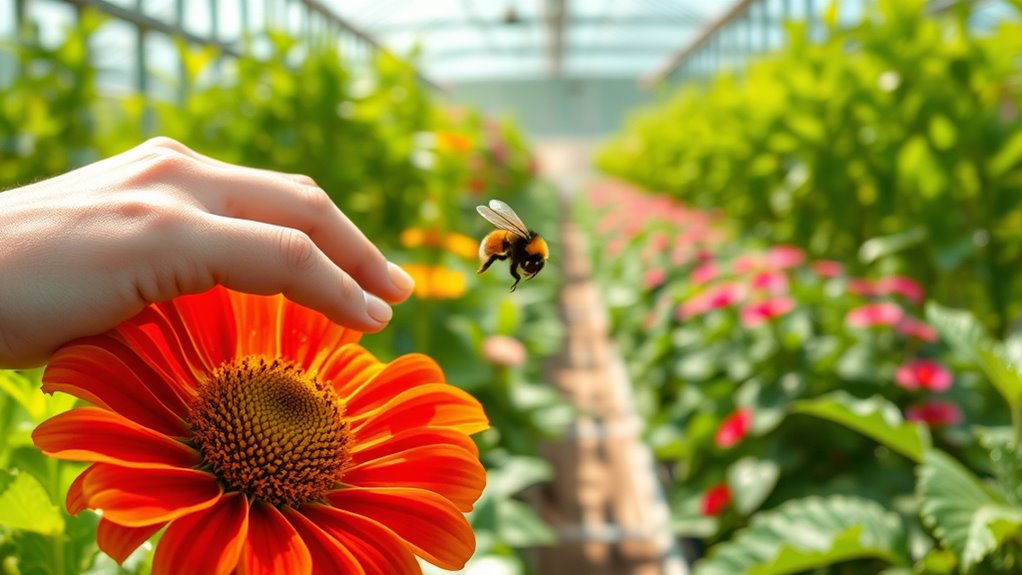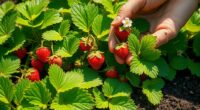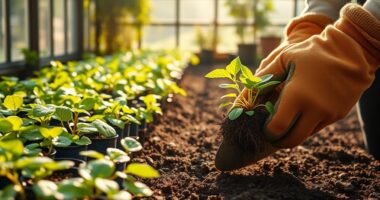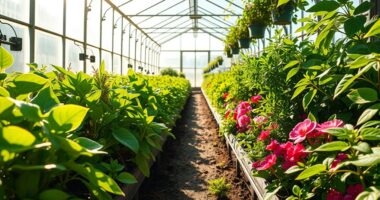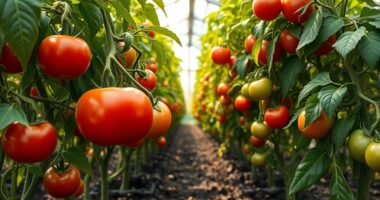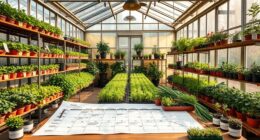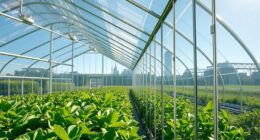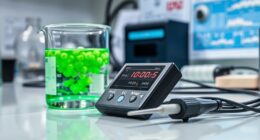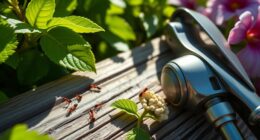To pollinate plants in a greenhouse, you can use a variety of methods like installing bumblebee hives or manually transferring pollen with brushes. Maintaining ideal conditions is essential; keep temperatures between 65°F and 85°F and humidity around 60%-75%. You should also guarantee good airflow to promote pollen movement. Attracting natural pollinators with nectar-rich flowers or using tools like vibrating wands can enhance your efforts. There's more to explore for successful greenhouse pollination techniques.
Key Takeaways
- Utilize bumblebee hives for efficient pollination, reducing manual labor and enhancing crop yield.
- Maintain greenhouse temperatures between 65°F and 85°F to support pollinator activity and pollen viability.
- Use tools like paintbrushes or vibrating devices for manual pollen transfer when natural pollinators are absent.
- Ensure good airflow with fans to promote pollen movement and prevent clumping due to high humidity.
- Attract pollinators by planting nectar-rich flowers and ensuring bright, sunny conditions in the greenhouse.
Importance of Pollination in Greenhouses
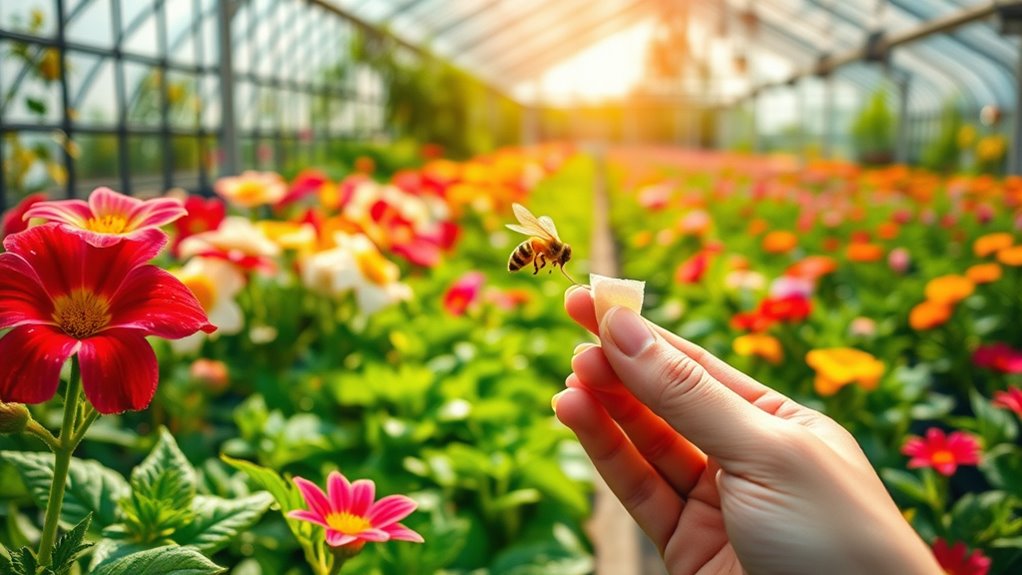
Pollination is essential for successful greenhouse gardening, as it directly influences the production of fruits and seeds.
In greenhouses, the lack of natural pollinators means you need alternative methods to guarantee effective pollination. When done right, you'll see increased yields and improved crop quality.
Utilizing natural pollinators like bees can greatly reduce your labor costs compared to manual pollination methods. Plus, protecting these pollinators allows you to cut down on pesticide use, which benefits the environment.
By facilitating pollen transfer, pollinators help crops like tomatoes, peppers, and strawberries thrive, enhancing uniformity and fruit size.
Ultimately, effective pollination not only boosts your harvest but also contributes to a healthier greenhouse ecosystem.
Methods of Pollination
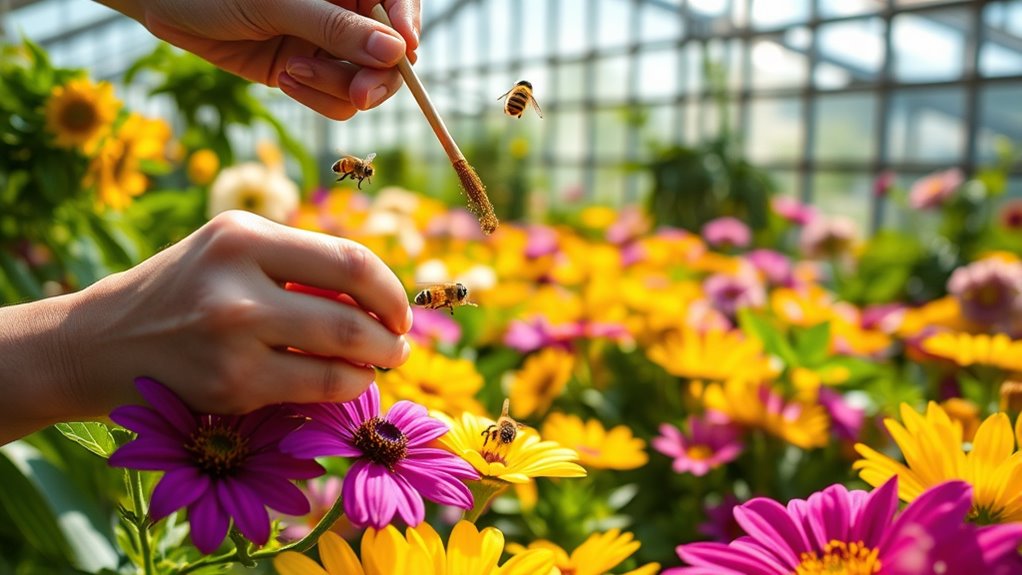
When it comes to ensuring your greenhouse plants thrive, understanding various methods of pollination is essential. You can utilize natural methods by allowing wind to circulate through vents or attracting insects like bees by planting nectar-rich flowers.
Installing bumblebee hives can enhance pollination efficiency. For assisted pollination, consider manual methods using paintbrushes or specialized vibratory devices to mimic insect actions.
Adjusting your greenhouse environment also plays a vital role; maintain temperatures between 65°F and 85°F and manage humidity levels between 50% and 80%.
Regularly monitor your plants, time your pollination efforts wisely, and transfer pollen gently for the best results. Each of these strategies can greatly improve your plants' pollination success.
Tools for Effective Pollination
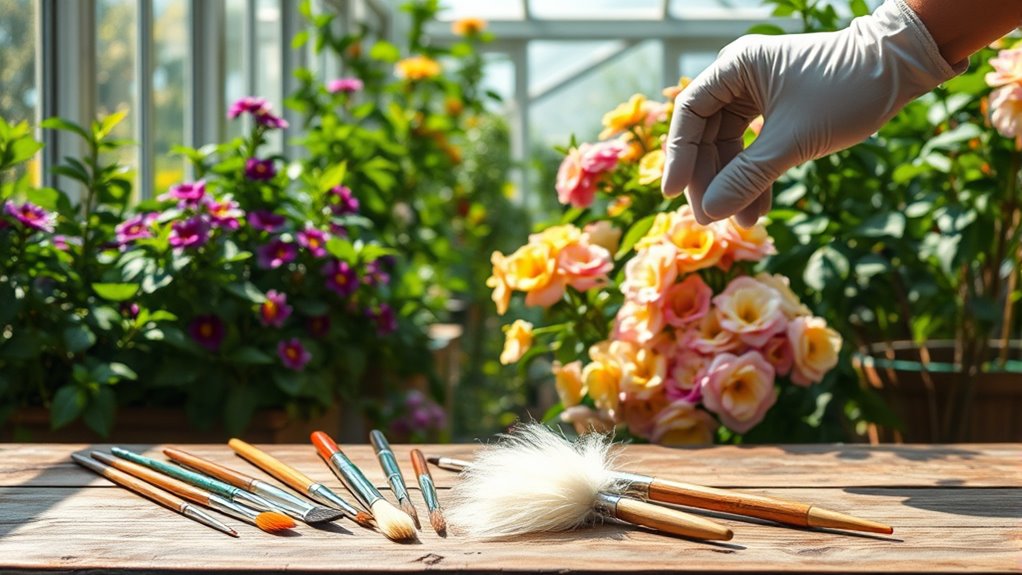
Effective pollination in a greenhouse requires the right tools to guarantee success. Start with a feather or artist paintbrush to gently transfer pollen between flowers.
Cotton swabs are perfect for delicate blooms, while a plastic spoon helps collect pollen from male flowers. For efficiency, consider using a specified pollination wand or an electric vibrating wand to enhance pollen release.
Mechanical devices like electric pollination wands and vibrating tools can mimic natural pollinators, aiding in pollen dislodgment. Pollen collection devices capture and transfer pollen effectively.
Don't forget air blowers or fans, which circulate air and disperse pollen throughout the greenhouse. With these tools, you can greatly improve your pollination efforts and boost your plant yields.
Optimal Environmental Conditions
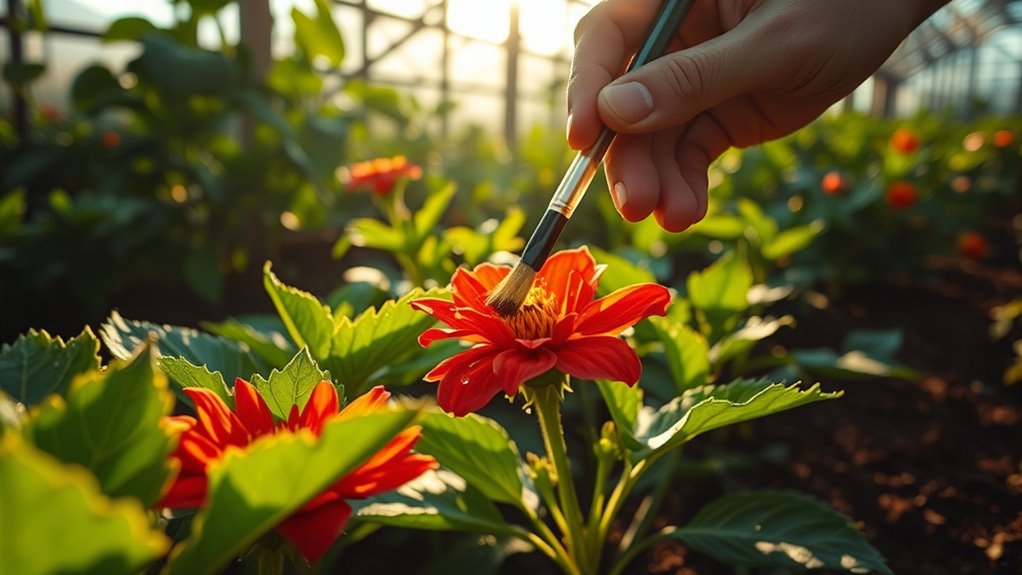
Creating the right environment in your greenhouse is vital for successful pollination. Aim for temperatures between 65°F and 85°F, as extremes can hinder pollen growth. Keep flower temperatures below 95°F to guarantee effective pollination.
Maintain relative humidity between 60% to 75% for conventional setups or 70% to 85% in semi-closed systems; both high and low humidity can disrupt pollen transfer.
Good airflow is essential—use vents and fans to promote circulation and prevent disease. Bright, sunny conditions benefit pollination, but consider shading techniques during peak heat.
Lastly, consistency is key. Monitor and maintain steady temperature and humidity levels to achieve ideal plant health and pollination efficiency.
Attracting Natural Pollinators
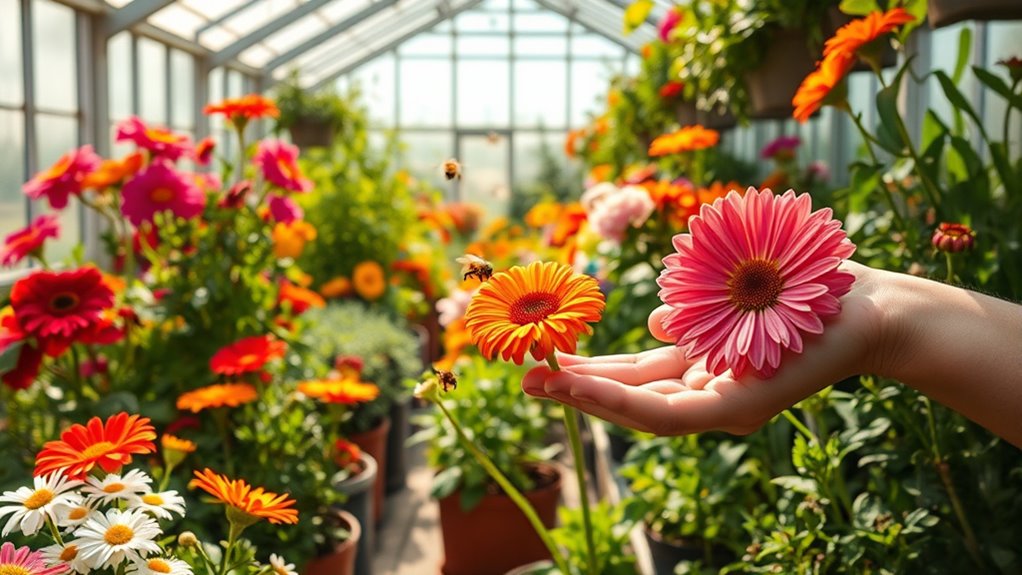
To maximize pollination in your greenhouse, attracting natural pollinators can greatly enhance your efforts.
Start by planting nectar-rich flowers like lavender, cosmos, and milkweed near vents and doors to invite bees, butterflies, and other beneficial insects. These creatures can easily enter through cracks and openings, increasing your pollination success. Additionally, having a portable camping toilet nearby can help maintain cleanliness in your greenhouse environment, ensuring that pollinators feel welcome.
Plant nectar-rich flowers like lavender and cosmos near vents to attract beneficial pollinators and boost your greenhouse's pollination success.
Guarantee diversity in your plant selection to provide a constant supply of nectar and pollen. Additionally, consider modifying your greenhouse structure by opening vents and removing screens to allow easier access for these pollinators.
Providing water sources and installing nesting boxes for bees can further support their presence. By creating a welcoming environment, you'll encourage natural pollinators to thrive and help your plants flourish. It's also important to remember that bees typically forage within a 1-3 mile radius from their hive, so planting nearby can be beneficial.
Common Challenges in Greenhouse Pollination
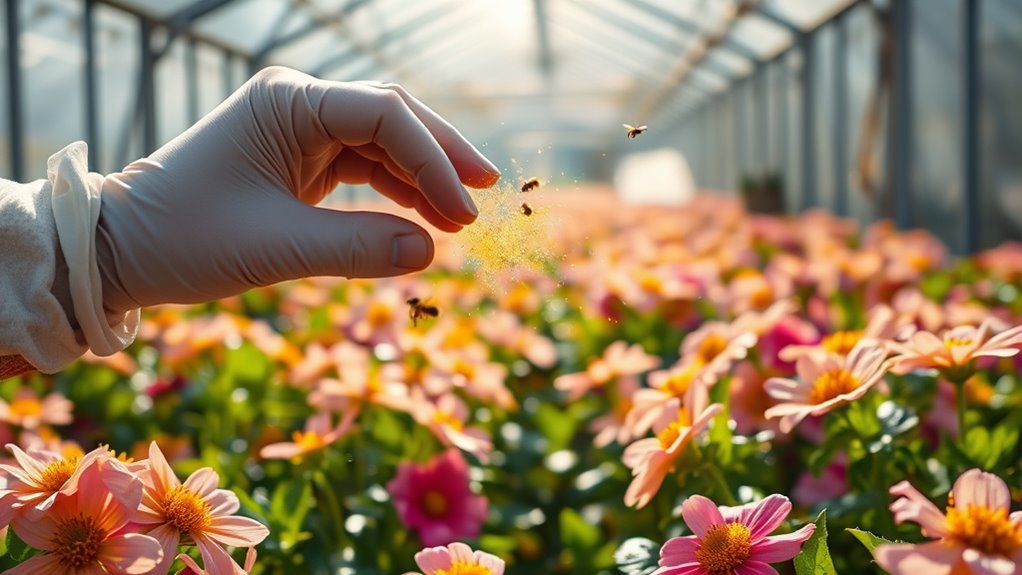
While maximizing pollination in your greenhouse can yield great results, various challenges can stand in your way.
Temperature control is essential—extreme heat or cold can hinder pollinator activity and pollen viability. High humidity may cause pollen grains to clump, making transfer difficult, while poor airflow restricts natural pollen movement. Insufficient light can impact plant health and pollinator activity, and unstable climate conditions can stress your plants, reducing viable pollen production.
Moreover, the lack of natural pollinators due to greenhouse isolation means you might need alternative methods. Each plant species has unique pollination requirements, which adds complexity.
Finally, the time and cost of using manual or mechanical pollination methods can strain your resources, making effective management critical for success.
Solutions for Successful Pollination
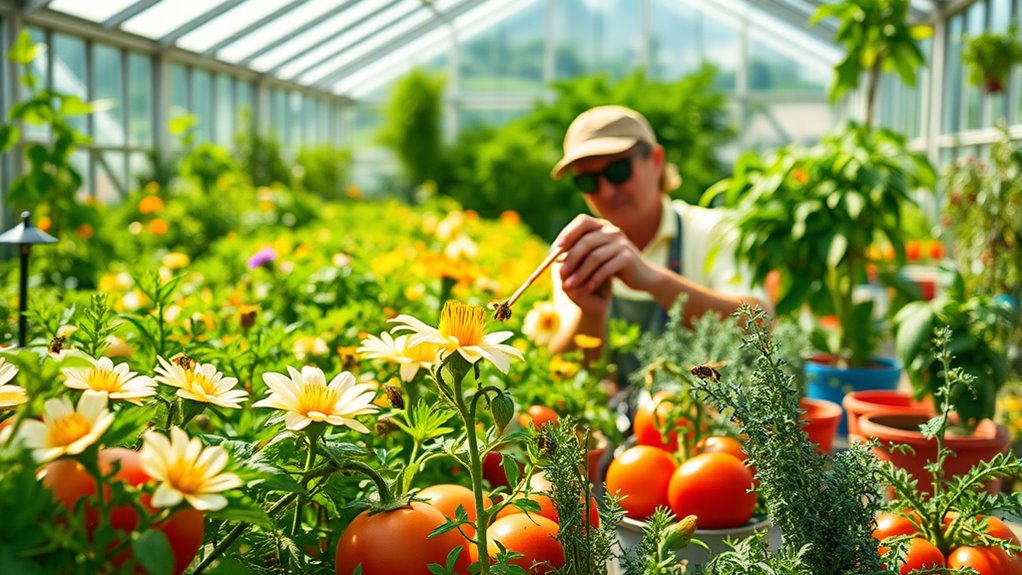
Successfully pollinating plants in a greenhouse requires a proactive approach to overcome the challenges discussed earlier.
Start with manual pollination techniques, using a small paintbrush to transfer pollen or gently shaking plants to release it. Focus on self-pollinating varieties that need little assistance and aim for pollination between 10 a.m. and 3 p.m.
Attract natural pollinators by planting nectar-rich flowers, installing hives, and ensuring water sources are available.
Optimize your greenhouse conditions by maintaining the right temperature, humidity, and airflow. You can also employ vibrating devices or electric toothbrushes to aid in pollination. Additionally, consider incorporating non-toxic XL houseplants to create a more diverse and inviting environment for pollinators.
Combining these methods and tracking your progress will enhance your chances of a successful fruit set. Regularly inspect your plants for signs of success.
Frequently Asked Questions
How Often Should I Pollinate My Plants in the Greenhouse?
You should pollinate your plants daily, especially for crops like tomatoes that thrive on consistent pollination.
Aim for the hours between 10 a.m. and 3 p.m. when conditions are ideal. Remember, some flowers might need multiple visits to guarantee proper pollination.
Always check that your plants are healthy and vigorous.
Keep an eye on humidity levels too, as high humidity can interfere with pollen release, affecting your pollination efforts.
Can I Use Artificial Lights During Pollination?
Imagine a sunlit garden where flowers bloom in harmony, but you're stuck inside.
Yes, you can use artificial lights during pollination! They play an essential role by extending daylight hours, enhancing plant growth, and attracting pollinators.
Just make sure the light spectrum supports your plants and monitors intensity.
By mimicking natural light conditions, you can create an inviting environment that boosts pollination efficiency.
Your plants will thrive, and so will the pollinators!
What Plants Benefit Most From Bumblebee Pollination?
If you're looking to maximize your garden's yield, focus on plants like tomatoes, sweet peppers, and strawberries.
These crops thrive with bumblebee pollination, as the bees enhance fruit set and quality.
Berries such as blueberries and raspberries also benefit greatly, ensuring robust production.
Don't overlook soybeans; they rely on bumblebees for improved crop quality.
Incorporating these plants in your garden will help you take full advantage of bumblebee efficiency.
Are There Specific Times of Day for Effective Pollination?
Yes, there are specific times of day when pollination is most effective.
You'll find that morning hours are ideal, as pollen is more viable and stigmas are receptive. Aim for temperatures between 16°C and 30°C, and keep humidity levels around 60-75%.
If you're dealing with plants like peppers, pollinate at midday to prevent blossom drop.
How Do I Know if My Plants Are Pollinated Successfully?
To know if your plants are pollinated successfully, look for visual changes like wilting petals and swelling at the flower's base, which indicates fruit formation.
You should also observe increased activity from pollinators like bees. Healthy plants are more likely to bear fruit, so monitor their overall condition.
Finally, guarantee ideal environmental conditions, as the right temperature and humidity levels can greatly impact successful pollination.
Conclusion
In summary, successfully pollinating plants in your greenhouse is like orchestrating a beautiful symphony; each method and tool plays an essential role. By understanding the importance of pollination, utilizing effective techniques, and creating ideal conditions, you can guarantee a thriving environment for your plants. Don't forget to attract natural pollinators and be prepared for challenges. With these strategies, you'll cultivate a flourishing greenhouse, filled with vibrant blooms and bountiful harvests. Happy gardening!
